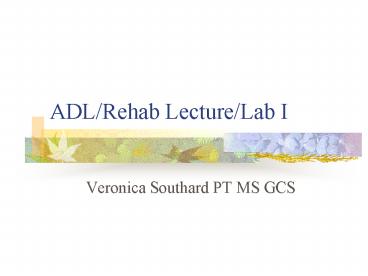ADLRehab LectureLab I - PowerPoint PPT Presentation
1 / 32
Title:
ADLRehab LectureLab I
Description:
Car transfers. Snack prep/Prepare meal/Light cleaning. Bedmaking. Ironing/Hangout wash ... Visual, auditory, tactile, mirrors, polaroids. Progression of learning ... – PowerPoint PPT presentation
Number of Views:41
Avg rating:3.0/5.0
Title: ADLRehab LectureLab I
1
ADL/Rehab Lecture/Lab I
- Veronica Southard PT MS GCS
2
What are ADLs/IADLs?
- ADL (self care)
- Drinking
- Dressing
- Washing face,comb hair
- Makeup/shave,Clean teeth
- Indoor mobility/floor to stand
- Eating/bathing
- Bed to chair
- Lavatory
- IADL household
- Cope with money
- Prepare hot drinks
- Car transfers
- Snack prep/Prepare meal/Light cleaning
- Bedmaking
- Ironing/Hangout wash
- Carry shopping
3
Definitions
- Mobility- skill required to solve movement
problems confronted during ADLs
4
Gentiles Taxonomy
- Components of a response to a motor problem
- Problem recognition
- Goal selection
- Strategy to meet goal
- Formulation of a motor plan
- Implementation of strategy
- Feedback
5
Types of impairments
- Motivational
- Musculoskeletal
- Neurological
- Cardiovascular
- Pulmonary
- Cognitive
- Perceptual
6
Task difficulty
- The desired outcome determines how simple or
complex the action. - Body stability/body transport.
- Open vs closed environments.
7
Performance environment
- Changes in time and space make the environment
more difficult. Informational processing demands
will increase performance difficulty
8
Task specificity
- Learning and performance are task specific. To
improve a particular task, practice that task!
9
Feedback
- Critical to learning
- Visual, auditory, tactile, mirrors, polaroids
10
Progression of learning
- 1. Cognitive learning occurs optimally if the
goals, outcomes, and processes are explicit.. - 2. Associative learning Start to withdraw
assistance further, allow time for pt. processing
of performance outcomes. Pt self corrects as
errors are detected. - 3. Autonomous learning Impose a distractor to
increase automatic tasks. Once the movement has
been truly learned, the pt. Will be able to
maintain accurate performance in spite of
distractors.
11
Verbal Cues
- Identify for the patient the elements of the
intended movement essential for successful
performance.
12
Visual imagery and Mental Practice
- Visually, kinesthetically, both.
- Research has shown Pt.s using mental practice
move more efficiently when compared to those who
didnt
13
Structuring your session
- Block practice
- Scattering practice
- Cognitive impairment be careful with too many
intertrial variables.
14
Task Analysis
- What is preventing the client from completing the
activity? - To turn to the side requires
- Rot and neck flex
- Hip and knee flex
- Flex of shoulder and protraction of sh girdle
- Rot of trunk
15
Functional Assessments
- Series of measures that describe the action of a
part of the body or quantifies a pts individual
performance as they relate to daily activities.
16
Quantification of Function
- Is necessary in order to establish baselines and
endpoints for measuring pt. outcomes
17
Outcome measures
- Standardized tests of functional tools that
relate pain, strength or ROM to a quantifiable
scale
18
Functional Outcome Tools
- Methods of describing and monitoring patient
performance. - Been around since the 1950s
- Performance and self report versions
19
Performance vs. Self Report
- Performance
- Better reproducibility, more sensitive to change
- Excellent for showing validity
- Better for cognitively impaired
- Self report
- Influenced by language, culture,education
20
The Title of the Tool
- Self Report Questionnaire
- Barthel
21
Self Report
- Adults, low level outpatients with RA.
- Measures level of difficulty with 8 ADLs
- Pen and Pencil
- Higher the score the greater the deficits
22
The Barthel Index
- Adults, measure of independence able to score
improvement in rehab. - Can be used as a pre and post test
- Pen and pencil or performance format
- Self report 5 minutes., performance 20 minutes
- 0,5,10,15scoring, with 0 the most dependent
23
Barthel cont
- 100 the pt.can care for himself, but not
necessarily alone. Scores gt 60 can live
independently, less than 60 require
institutionalization or daily assistance. - Strong content validity
- Only moderate interrater reliability
24
Pt. care
- At first meeting the pt.
- 1. Should know who you are
- 2. What the goals of treatment are
- 3. Expected outcomes and risks
25
Pt and family education
- Why should every pt get a HEP?
26
Goals
- Objective, measurable and include a time frame.
- STG very specific and may be a component of a LTG
- How you modify your goals often lets you know how
effective you are.
27
HEP
- Done prior to D/C
- Reviewed with the assisting caregiver as
necessary. - A written copy is always kept in the pt.s chart
28
Criteria for Inclusion in HEP
- Pt. Name
- Frequency of performance
- Number of reps
- Precautions/contraindications
- Required supplies/equipment
- Specific instructions/diagrams
- Therapists name and phone number.
- Sometimes it is handy to put next appt.
29
Communication
- Necessary for optimal rapport
- Pt.
- Caregiver
- Other team members
- MD
30
Types of Communication
- Verbal- actively express terms and concepts in a
way the pt. can understand. - Use laymans terms.
- Short and concise commands.
- Vary the volume, tone, inflection of your voice.
- Body language should match what you are saying.
- Eye contact is important
31
Non Verbal Communication
- Majority of pt. Interactions
- Made up of facial expressions, posture, gestures,
body movement, or changes in body responses. - Planned, spontaneous, uncontrollable or
voluntary. - Touch- be careful the proper message is conveyed
32
Safety Considerations
- You are responsible for you pt.
- Assure that all the equipment you use and the
environment is safe in your clinic. - The pt. is responsible for his health and safety
within the confines of his abilities. - Severe medical problems, burns, SCI, DM, CP,
emotionally disturbed or children require
constant vigilance

